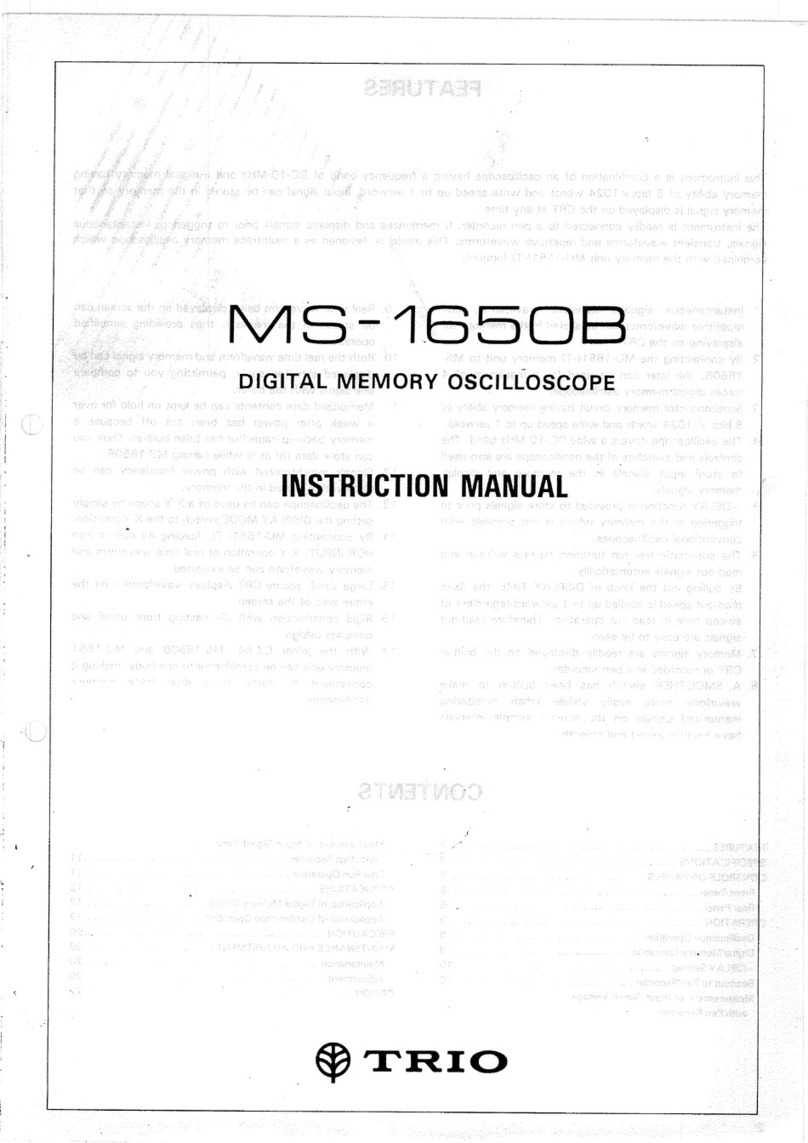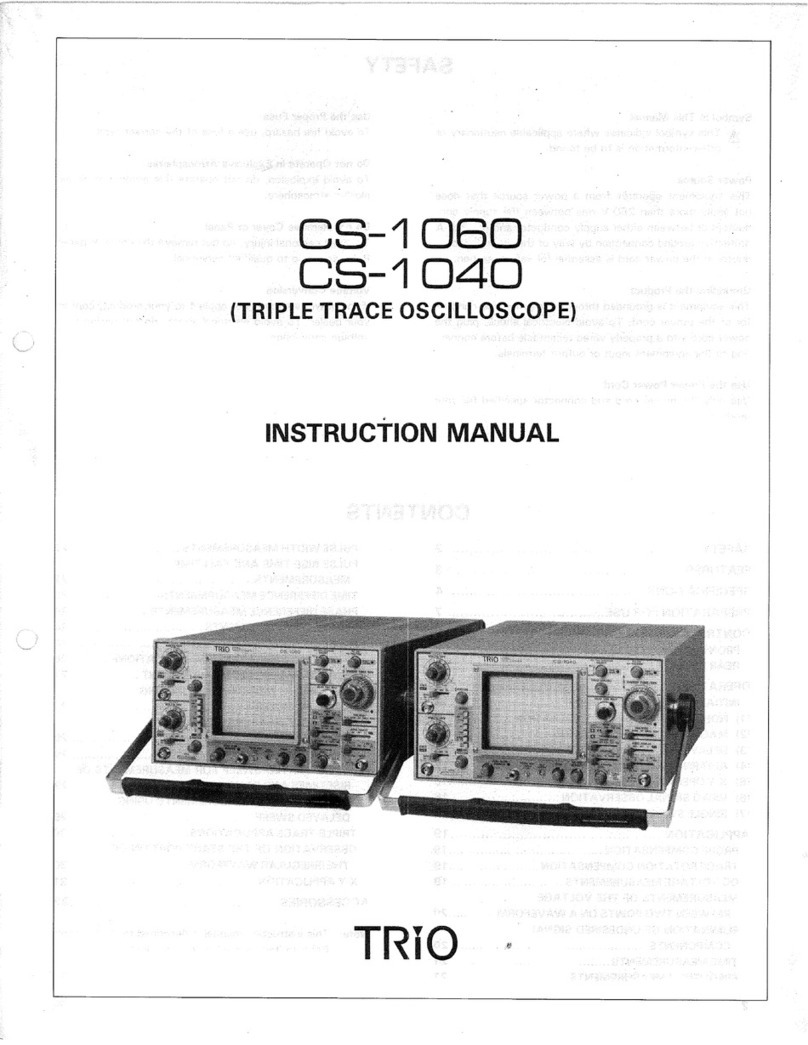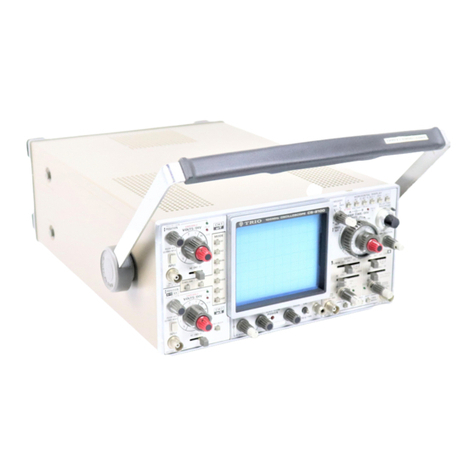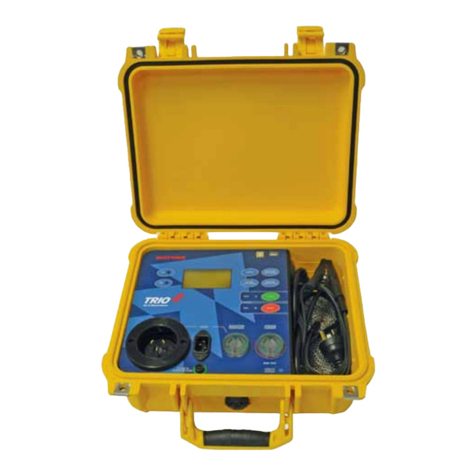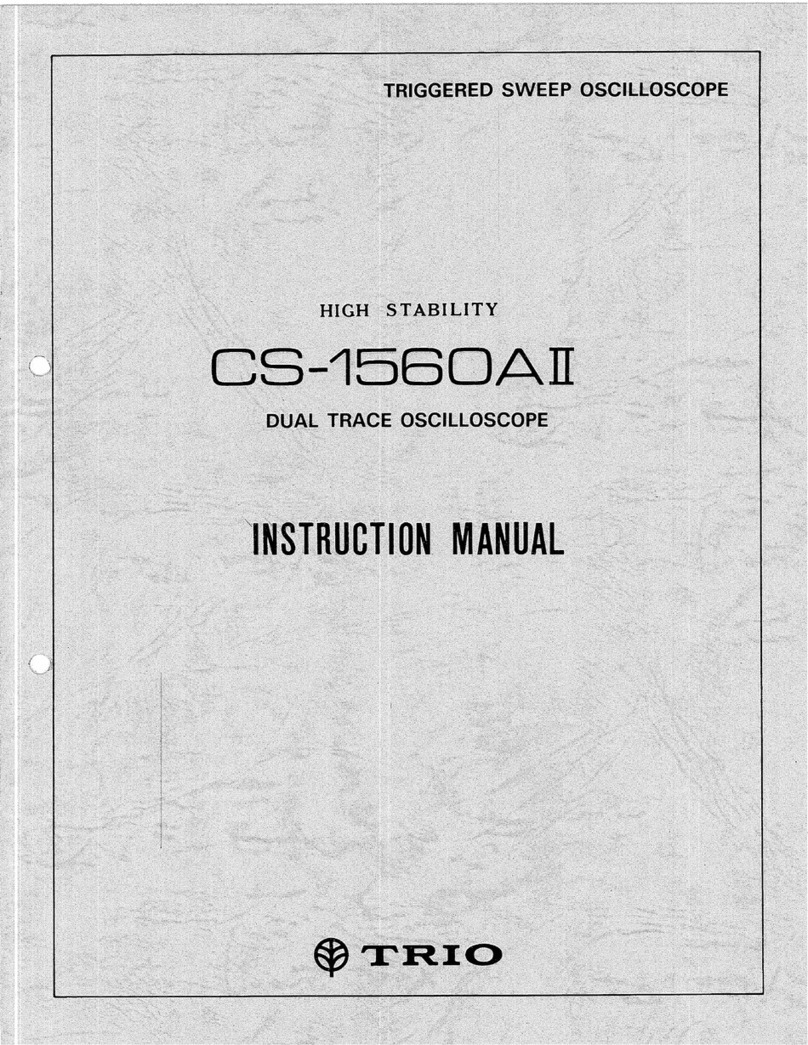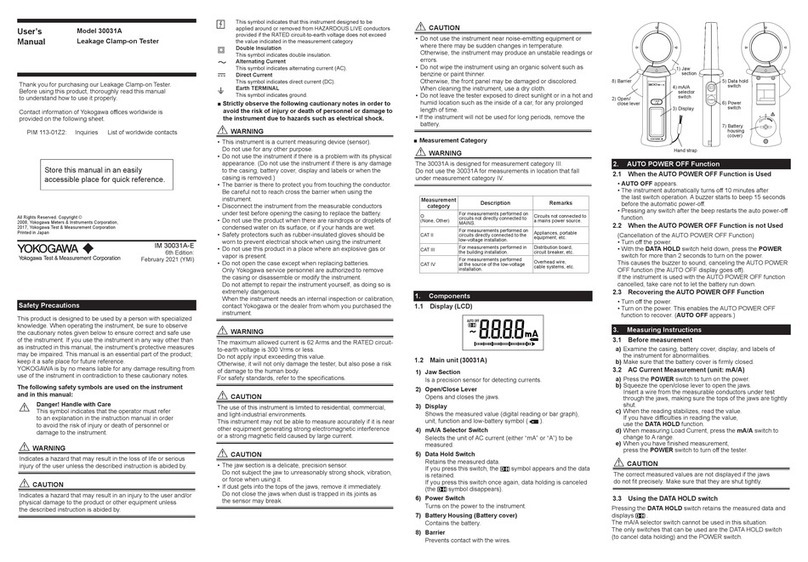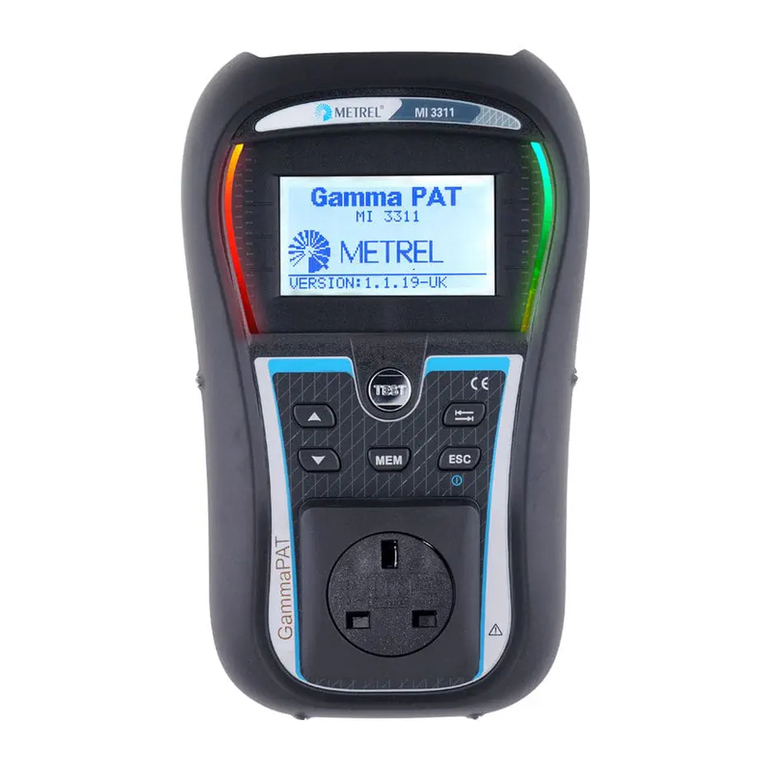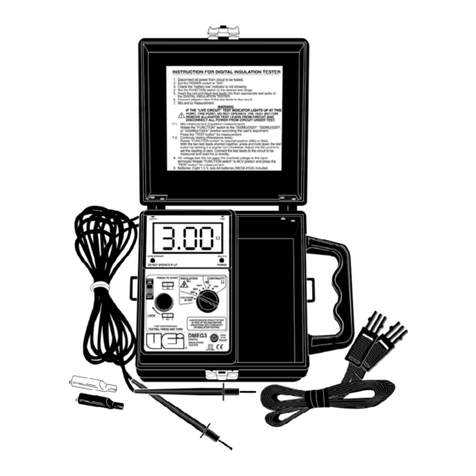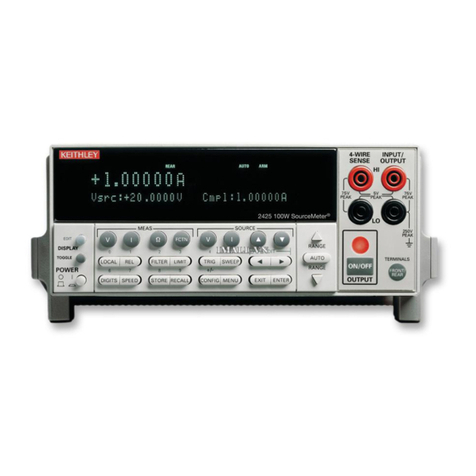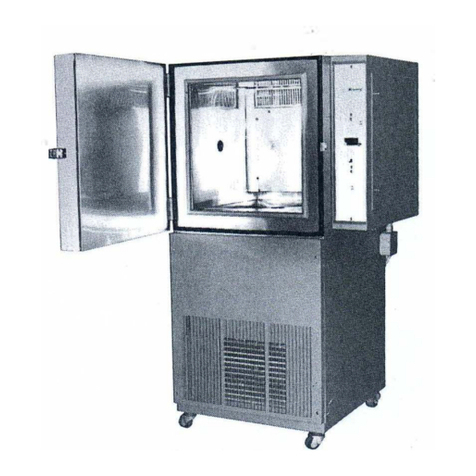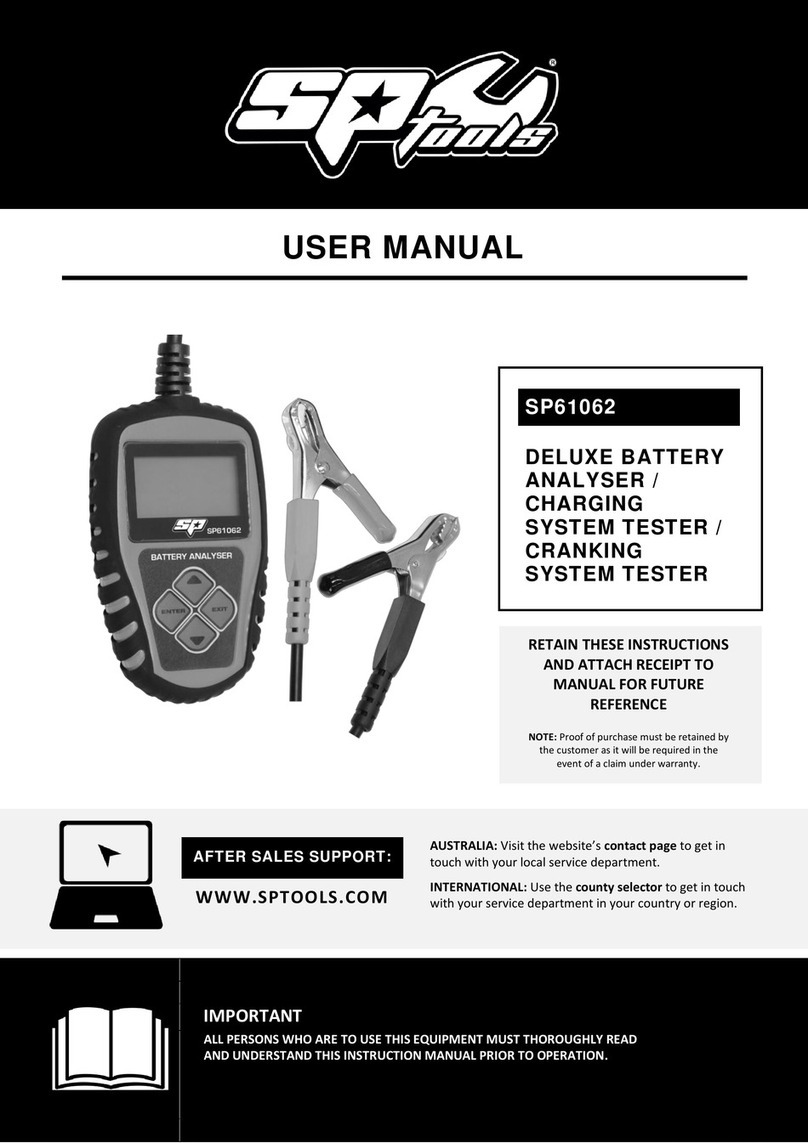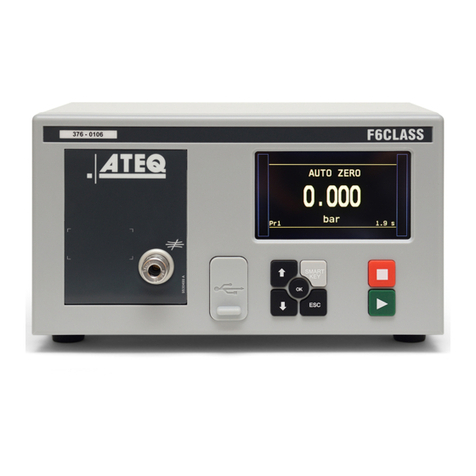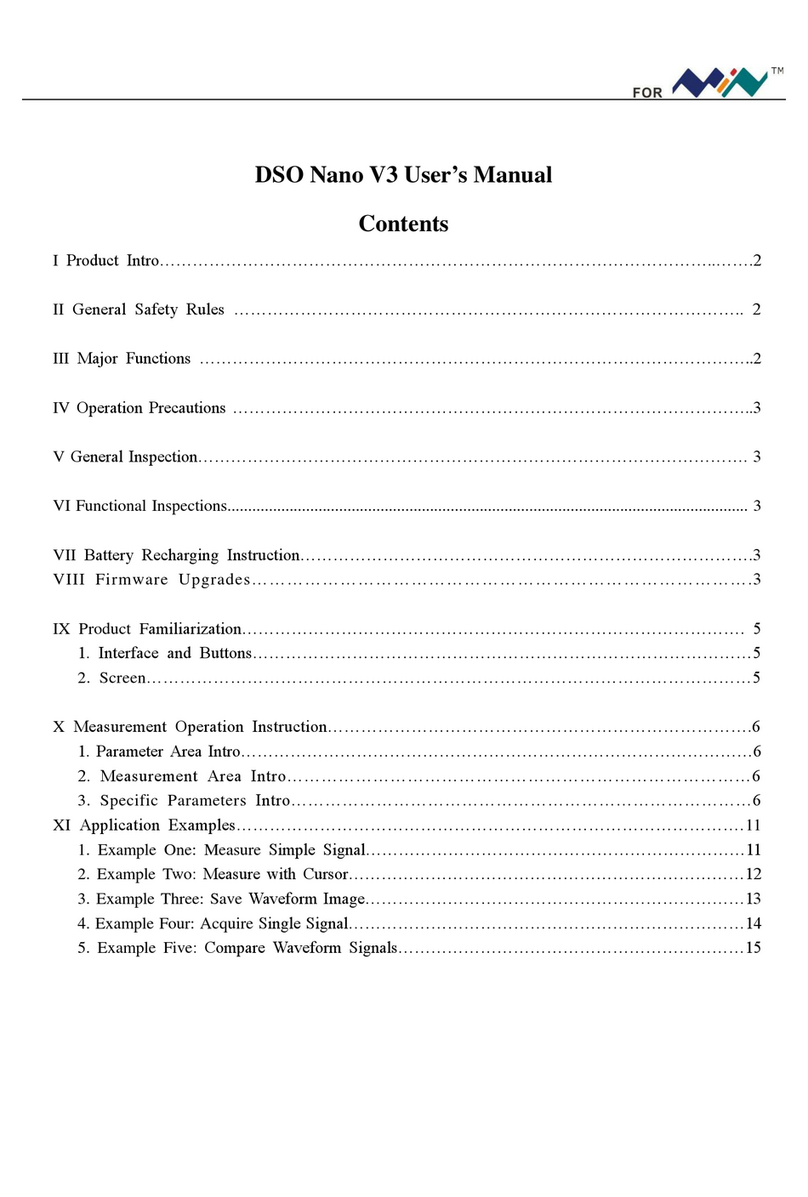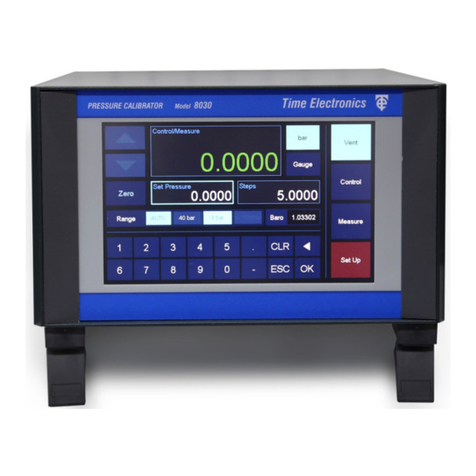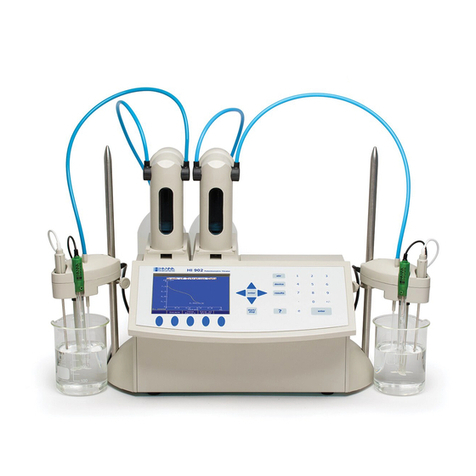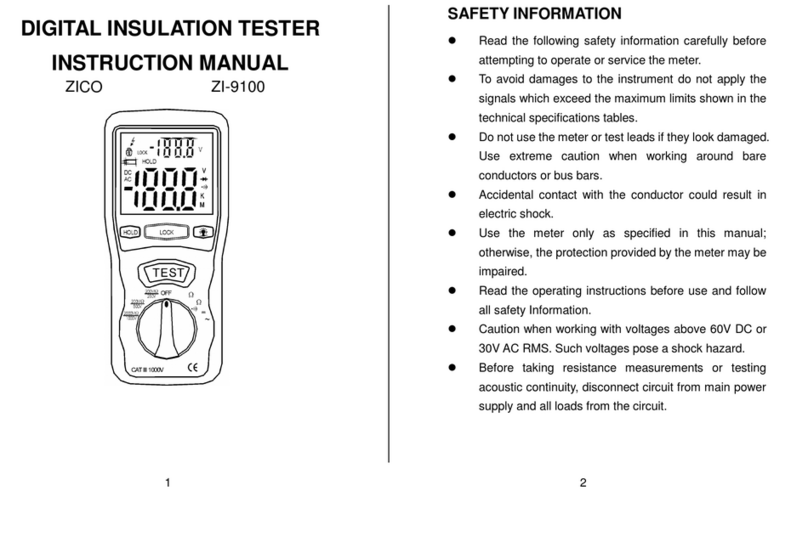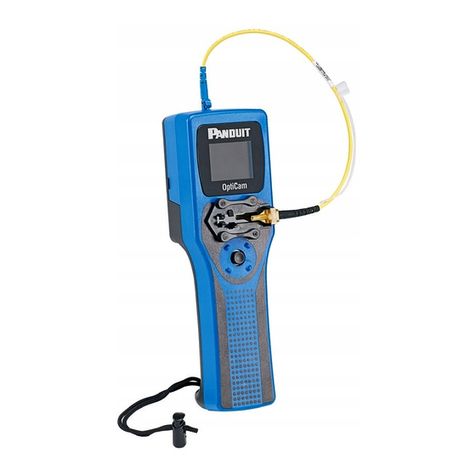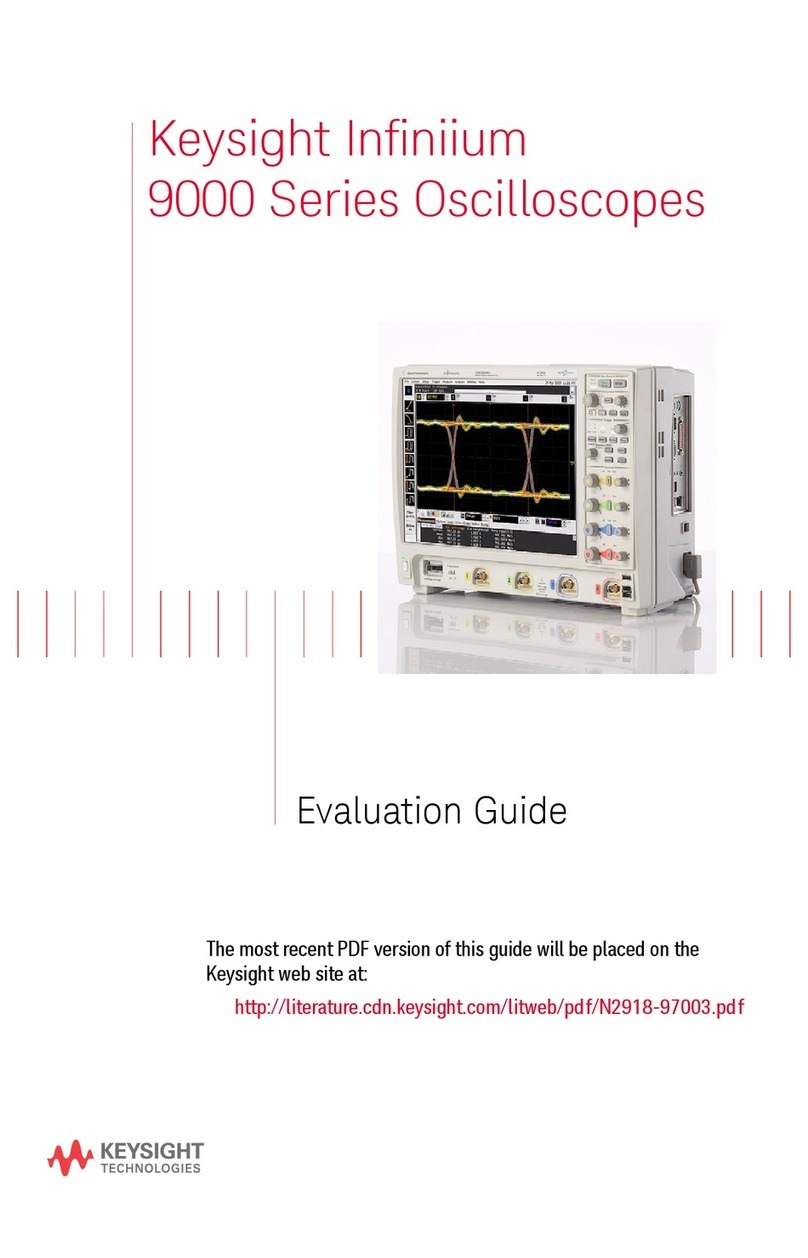Trio CS-1566A User manual

_.,
'
C102
TRIGGERED SWEEP OSCILLOSCOPE
HIGH
STABILITY
CS-1566A
DUAL
TRACE OSCILLOSCOPE
INSTRUCTION
MANUAL
$TRIO

FEATURES
• Vertical axis
with
wide
bandwidth
(20
MHz.
-3
dB) and high sensitivity (5 mV
/div.
1 div = 1
em).
•
AL
T and CHOP
operations
for
dual-trace
observation.
• The
time
base
switch
allows
changeover
between V (vertical) and H (horizontal)
of
VIDEO
sync
separator
circuit.
automatically
and
electronically.
• Distortion-free display
of
signals up to
20
MHz
on
the full area
of
CRT
screen.
• High sensitivity
CRT
(rectangular
with
internal
graticule)
with
excellent beam permeability has
sufficient
brightness
for
measurements
of
high-speed pulses
of
high frequencies.
• INT.
CH
1. CH2. LINE and EXT can be
individually synchronized for selection of desired
sync signals.
• The high voltage
power
for
CRT
as
well the
power for other circuits
is
fully stabilized
because of the use of
DC-
DC
converter. thus the
sensitivity and brightness are completely free
from effects
of
voltage variations.
•
At
AUTO position
of
TRIG LEVEL.
it
is
possible
to
check the brightness at no-signal
time
and
to
adjust triggering level
of
input waveforms.
• The adoption
of
ICs
throughout assures high
performance and improved reliability.
• X-Y operation is possible
with
CH2 amplifier
used
as
X axis. The horizontal axis sensitivity
is
as
high
as
5mV/div.
2
CONTENTS
Page
FEATURES ............................................................................... 2
SPECIFICATIONS...................................................................... 3
CONTROLS
ON
PANELS.......................................................... 5
Front Panel........................................................................... 6
Rear Panel
.. ..
..
..
.
.. .. .. .. ..
..
.. ..
.
..
..
..
..
..
..
.....
..
..
..
..
.....
.. .. ..
...
..
.
..
..
..
.. 8
OPERATION............................................................................. 8
Preliminary Operation............................................................ 8
Operating Procedures............................................................ 9
Measurement
of
Pulse Rising (Falling)
Time..........................
9
APPLICATIONS ......................................................·......·
..
···
..
·..
10
Dual-trace Applications ..............................···························
10
Single-channel Applications................................................... 19
FM
Receiver Adjustments .....................................................
22
X-Y Operation Applications ..................................
·.
···············
22
Amplifier Square Wave Test..................................................
24
PRECAUTIONS.........................................................................
29
MAINTENANCE AND
ADJUSTMENT........................................
29
Maintenance.........................................................................
29
Adjustment...........................................................................
30
SCHEMATIC DIAGRAM ............................................................
33

SPECIFICATIONS
Cathode
Ray
Tube
Type:
C5S106P31B
Acceleration
voltage:
2 kV
Scale:
8 div x
10
div
(1
div
=
9.5
mm)
Vertical
Amplifier
(for
Both
CH1
and
CH2)
Deflection
Factor:
5
mV/div
to
20V/div
±5%
Attenuator:
5
mV/div
to
20V/div.
1-2-5
sequence
Precisely adjustable in all
12
ranges.
Sensitivity error between ranges is ±
5%.
Input
impedance:
1 MH
±2%
Input
capacitance:
Approx.
27
pF
Frequency
response:
DC
DC
to
20
MHz
(less than
-3
dB)
15
mV/div
""' 1OV/div]
AC 2
Hz
to
20
M
Hz
(less than
-3
dB)
15
mV/div
,.__,
10V/div]
Risetime:
Less than
17.5
nsec.
Overshoot:
Less than 3% (at
100
kHz square wave)
Cross-talk:
ALT Less than
-60
dB
CHOP Less than
-50
dB
Operating
modes:
CH
1
CH
1 only
CH2 CH2 only
ALT
CHOP 2-channel
with
AL
T (alternate sweep)
2-channel
with
CHOP
ADD
2-channel algebraic sum
(CH
1 + CH2)
CHOP
frequency:
Approx.
200
kHz
Maximum
input
voltage:
600
Vp-p
or
300V
(DC + AC peak)
Invert
polarity:
CH2 only
Sweep
Circuit
Sweep
system:
Triggering sweep and auto sweep (free-running
sweep
at
no-signal time)
Sweep
time:
0.
5J..Ls/div
to
.
5s/div
±5%
and X-Y.
1-2-5
sequence
Fine
adjustment
in all
19
ranges
Magnification:
10times±5%(PULL
x
10MAG)
Linearity:
Better
than 3% (2
J..LS/div
to
0.5s/div)
Better
than 5%
(0.5
J..LS/div
to 1
J..LS/div)
Better
than
10%
( x
10
MAG)
Triggering
Source:
INT. CH1. CH2. LINE. EXT
Slope:
NORM
Positive and negative
VIDEO
Positive
and
negative
(LINE and
FRAME
automatically
selected
by
SWEEP
TIME/DIV)
LINE (TV-line):
0.5
J..LS/Div
to
50
J..LS/div
FRAME (TV-Frame): 0.1
ms/div
to
0.5s/div
Sensitivity:
Tngger
Minimum
Sync Voltage
Bandwidth
Type INT
NOR
50
Hz~
15
MHz
0 5 div
20
Hz
~20
MHz
1 0 div
AUTO
50Hz~15MHz
0.5
diV
20
Hz~20
MHz
1.0 div
VIDEO VIDEO signal 1 0 div
External
triggering
input
voltage:
50V
(DC + AC peak)
EXT
05
Vp-p
1.0Vp-p
0.5
Vp-p
1.0 Vp-p
1.0 Vp-p
Horizontal
Amplifier
(CH2
input)
Operating
modes!
(Except
x
10
MAG)
X-Y mode is selected by SWEEP
TIME/DIV.
CH
1:
Y axis
CH2: X axis
Deflection
Factor:
Same
as
CH
1 (5
mV/div
to
20V/div
±5%)
Frequency
response:
DC
DC
to
2
MHz
(less than
-3
dB)
AC 2
Hz
to
2 M
Hz
(less than
-3
dB)
Input
impedance:
Same
as
CH1
(1
MU
±2%)
Input
capacitance:
Same as
CH
1 Approx.
27
pF
X-V
phase
difference:
Less than
3°
at
70
kHz
3

Calibrating
Voltage
0.1 V
±3"'!0
(at reference level
OV)
1 kHz
±3%
(square wave, positive)
Intensity
Modulation
Input
voltage:
TTL level
Input
impedance:
15
kH
±20%
Bandwidth:
DC
to 5
MHz
Maximum
input
voltage:
50V
(DC + AC peak)
Trace
Rotation
Trace angle is adjustable by panel surface ad-
justor.
Power
Requirements
Power
supply
voltage:
100/
120/220/240V
± 10%. 50./60
Hz
Power
consumption:
47W
4
Dimensions
Width:
260
mm
(277
mrn)
Height:
190
mm
(204
mrn)
Depth:
328
mm
(393
mrn)
Figures in ( )
show
maximum
sizes.
Weight:
8.4
kg
Accessories
Probe (PC-22)
...........................................
2
Damping:
1/10
Input impedance:
10
Mf!
Input
capacitance: Less than
18
pF
Instruction
manual.
Replacement fuse:
0.5A.
0.8A
...........
. 2
2

FRONT
PANEL
REAR
PANEL
32
CONTROLS ON PANELS
Fig. 1
31
27
29
Fig. 2
13
12
22
21
28
((.-J+---+H~--1
6
;;y-----------+H~------1
9
26
30
((~---Hr'YJ------2
4
18
25
11
5

FRONT
PANEL
1.
~
POSITION
Vertical position
adjustment
for
Channel 1 trace.
Becomes
vertical
position
adjustment
when
SWEEP
TIM
E/DIV
switch
(21)
is in
the
X-Y posi-
tion
(X-Y operation).
2.
INPUT
Vertical
input
terminal
for
CH
1 (or in X-Y mode).
3.
AC-GND-DC
AC:
Blocks DC
component
of
input
signal.
GND:
Opens signal
path
and ground
input
to
vertical amplifier. This provides a zero-
signal base line,
the
position
of
which
can
be
used
as
a reference
when
performing
DC
measurement.
DG: Direct
input
of
AC and DC
component
of
input
signal.
4.
VOLTS/DIV
Vertical
attenuator
for
Channel 1
which
provides
step
adjustment
of
vertical sensitivity. Vertical sen-
sitivity
is calibrated in
12
steps
from
5
mV
to
20
volts per div
when
VARIABLE
control (5) is set
to
CAL position. This
control
adjusts vertical sen-
sitivity
when
the SWEEP
TIME/DIV
switch
(21)
is
in
the
X-Y
position
(X-Y operation).
5.
VARIABLE
Vertical
attenuator
adjustment
provides fine control
of
vertical sensitivity. In
the
extreme
clockwise
(CAL) position,
the
vertical
attenuator
is calibrated.
This control
becomes
the
fine vertical gain
control
when
the SWEEP
TIME/DIN
switch
(21) is in
the
X-Y position.
6.
MODE
Five-position lever
switch;
selects the basic
operating modes
of
the oscilloscope.
CH
1: Only the
input
signal
to
Channel 1 is dis-
played as a single trace.
CH
2: Only the
input
signal
to
Channel 2 is dis-
played
as
a single trace.
ALT: Dual-trace operation, in
which
sweep
alternately
displays
Channel
1,
then
Channel 2,
input
signal.
Recommended
for
sweep
times
of
0.5
ms/div
to
0.5
J.1S/
div.
CHOP:
Dual-trace operation in
which
sweep
is
chopped at
approximate
200kHz
rate and
switched
between
Channel 1 and Channel
2 traces. Recommended
for
sweep
times
of
0.5
s/div
to
1
ms/div.
6
ADD:
The
waveforms
from
Channel 1 and
Channel 2
inputs
are added and
the
sum is
displayed as a single trace.
When
the
Channel 2 POSITION
control
is pulled
(PULL
INVERT),
the
waveform
from
Channel 2 is
subtracted
from
the
Channel
1
waveform
and
the
difference
is
dis-
played as a single trace.
7.
VOLTS/DIV
Vertical
attenuator
for
Channel 2
which
provides
coarse
adjustment
of
vertical sensitivity. Vertical
sensitivity
is calibrated in
12
steps
from
5
mV
to
20
volts
per
div
when
VARIABLE
control
(8) is
set
to
the
CAL
position.
8.
VARIABLE
Vertical
attenuator
adjustment
provides
fine
control
of
vertical sensitivity. In
the
extreme
clockwise
(CAL) position,
the
vertical
attenuator
is calibrated.
9.
AC-GND-DC
AC: Blocks DC
component
of
input
signal.
GND:
Opens
si~1nal
path
and
grounds
input
to
vertical amplifier. This provides a zero-
signal base line,
the
position
of
which
can
be used
as
a reference
when
performing
DC measurements.
DC:
Direct
input
of
AC and DC
component
of
input
signal.
10.
INPUT
Vertical
input
terminal
for
CH2
or
X
input
terminal
for
X-Y operation.
11.
~
POSITION,
X-V
.,....,.,
PULL
INVERT
Vertical
position
adjustment
for
Channel 2 trace.
Becomes
horizontal
position
adjustment
when
SWEEP
TIME/DIV
switch
(21)
is in
the
X-Y posi-
tion
(X-Y operation).
When
the
knob
is pulled (PULL INVERT),
the
CH2
polarity
is inverted.
12.
POWER
LAMP
Glows
when
oscilloscope is
turned
on.
13.
POWER
Power
ON/OFF
switch.
The
power
is ON
when
the
knob is set
to
right.
14.
INTENSITY
Adjusts
the
brightness
of
spots and
waveforms
for
easy
viewing.
When
t1:nned
to
the
left
waveform
will
disappear.

15.
FOCUS
Spot
focus control to
obtain
optimum
waveform
according
to
brightness.
16. EXT
TRIG
External
trigger
terminal. For external triggering.
set SOURCE (17)
to
EXT and apply external
triggering voltage.
17.
SOURCE
Five-position lever
switch
selects
triggering
source
for
sweep.
INT:
In
CH
2 mode. Channel 2 signal
becomes
trigger. In
CH
1.
ALT. CHOP. and
ADD
mode. Channel 1 signal becomes trigger.
CH 1: Channel 1 signal becomes
trigger
in all
modes.
CH
2: Channel 2 signal becomes
trigger
in all
modes.
LINE:
Line
voltage
becomes
trigger.
EXT: Signal applied
at
EXT
TRIG jack becomes
trigger.
18.
SYNC
Four-position lever
switch
with
the
following
positions:
SLOPE:
The SLOPE
positions
are used for
viewing
all
waveforms
except
television
composite
video signals.
(t ):
Sweep
is triggered on
positive-
going
slope
of
waveform.
(-
):
Sweep
is triggered on negative-
going slope
of
waveform.
SYNC SWITCH
VIDEO(t)
VIDEO(-)
Fig.
3
VIDEO:
In
the
VIDEO positions.
the
sync pulses
of
a
composite
video
signal are used
to
trigger
the
sweep;
the
vertical sync pulses
(frame) are
automatically
selected
for
sweep
times
of
0.5
s/div
to
0.1
ms/div.
and horizontal sync pulses (line) are
automatically
selected
for
sweep
times
of
50
,us/div to
0.5
,us/div.
(+
):
Sweep
is
triggered
on
positive-
going
sync pulse.
(-
):
Sweep
is
triggered
on negative-
going
sync pulse.
19.
LEVEL, PULL
AUTO
Sync level
adjustment
determines
points
on
waveform
slope
where
sweep
starts;
(-)
equals
most
negative
point
of
triggering
and (
t)
equals
most
positive
point
of
triggering.
PULL
AUTO:
Push-pull
switch
selects
automatic
triggering
when
pulled
out
(PULL AUTO).
When
automatic
trigger-
ing. a
sweep
is generated even
without
an
input
signal.
20.
~""'POSITION,
PULL
X10
MAG
Rotation adjusts horizontal
position
of
traces (both
traces
when
operated in
the
dual trace mode).
PULL
X10
MAG:
Push-pull
switch
selects X
10
magnification
when
pulled
out
(PULL
X10
MAG);
normal
when
pushed
in.
21.
SWEEP
TIME/DIV
Horizontal coarse
sweep
time
selector. Selects
calibrated sweep
times
of
0.5
,us/div (microsecond
per division)
to
0.5
s/div
in
19
steps
when
VARIABLE
control
(22)
is set
to
the
CAL
position
(fully clockwise). In
the
X-Y position.
this
switch
disables
the
internal
sweep
generator
and
permits
the
CH 2
input
to
provide
horizontal
deflection
(X-Y
operation). The Channel 1
input
signal produces
vertical
deflection
(Y
axis) and
the
Channel 2
input
signal produces horizontal
deflection
(X axis).
22.
VARIABLE
Fine
sweep
time
adjustment.
In the
extreme
clockwise
(CAL)
position
the
sweep
time
is
calibrated.
23.
CAL 1 kHz, 0.1 Vp-p
Provides calibrated 1 kHz. 0.1
volt
peak-to-peak
square
wave
input
signal. This is used
for
calibra-
tion
of
the vertical
amplifier
attenuators
and
to
check
the
frequency
compensation
adjustment
of
the probes used
with
the
oscilloscope.
7

24.
GND
Ground terminal for the oscilloscope.
25.
TRACE
ROTATION
Used
to
adjust
the
position
of
horizontal trace.
26.
HANDLE
This handle also serves
as
a stand
of
the
os-
cilloscope.
REAR
PANEL
27.
AC
VOLTAGE
SELECTOR
Plug type AC voltage selector
to
operate the os-
cilloscope on specific
power
supply voltage.
100/117
/220/240V.
28.
FUSE
HOLDER
Fuse rated
at
1A should be used
for
1
00/11
7V
operation. For operation on
220/240V.
be sure
to
use a
0.5A
fuse.
29.
POWER
CONNECTOR
For connection
of
the supplied AC
power
cord.
30.
Z
AXIS
INPUT
Intensity
modulation
terminal.
TTL
logic-
compatible, high lo,gic increase brightness
low
logic
decrease brightness.
Wind
power
cord
when
the oscilloscope
is
to
be
carried or stored. They also serve as a stand
when
the oscilloscope is used in
upright
position.
OPERATION
PRELIMINARY
OPERATION
When
operating this oscilloscope. refer
to
panel
controls
and their functions.
When
starting this oscilloscope
set initially. set the operating controls as
follows
and the set
may
be turned on safely.
clockwise
(c}\L)J
Center
(PUSH)
I
Extreme
clockwise(
CAL)
Fig. 4
8

OPERATING
PROCEDURES
1. Select the position
of
the
power
voltage
selec-
tor
plug as
indicated
by
the
arrow
marks. Then
insert the supplied
power
cord to the
power
connector.
2. Turn
POWER/SCALE
ILLUM
(13) clockwise.
The
power
is
turned
to
ON and POWER lamp
(12) lights.
3.
Horizontal axis
will
be displayed.
When
trace
does
not
appear at
the
center
of
the
screen.
adjust~
POSITION (
1)
and
<4~
POSITION (20).
Adjust
brightness
with
INTENSITY (14).
If
trace is unclear.
adjust
FOCUS (15).
4. The oscilloscope
is
now
ready for measure-
ment
For measurement. proceed as
follows:
Apply
signal
voltages
to
the
INPUT
terminals
(2). (10). Then
turn
VOLTS/DIV
(4)
clockwise
until
the
waveform
is
correctly
displayed on
the
scope. By
setting
MODE
(6) and SOURCE
(
17)
to
CH
1.
the
CH
1
input
signal
to
the
INPUT
terminal
(2)
will
appear. Similarly. by
setting
MODE
and SOURCE
to
CH2.
then
the
input
signal
to
the
CH2
terminal
(10)
will
appear.
at
ALT
or
CHOP
position.
two
waveforms
(CH 1 and CH2)
will
appear on
the
scope.
With
SOURCE (
17)
set
to
CH
1.
the
CH
1
input
signal
from
the
INPUT
terminal
(2)
is fed
to
the
trigger
circuit
where
the
CH
1
signal is triggered.
Similarly.
when
SOURCE is
set
to
CH2.
the
CH2
signal is triggered.
Use
either
method
for easier observation.
At
ADD
position.
algebraic
sum
of
CH
1 and
CH2 is obtained.
When
PULL INVERT (11)
knob is pulled.
the
CH2 signal in reverse
polarity
is added
to
the
CH
1 signal in reverse
polarity
is added
to
the
CH
1 signal and
the
algebraic difference
between
CH
1 and CH2 is
displayed (SUB).
5.
When
the
signal
voltage
is more than 5
mV
and
waveform
fails
to
appear on the screen.
the oscilloscope
may
be checked by feeding in-
put
from
CAL
1 kHz. 0. 1
Vp-p
(23). Since
calibration
voltage
is 1 Vp-p,
the
waveform
becomes
5
div
high at
the
20
mV
/div
position.
6.
By pushing TRIG LEVEL (20). the free-running
auto
function
is released. The
waveform
dis-
appears
when
the
knob
is turned clockwise.
and appears again
when
it
is returned
to
its ap-
proximate
middle
position
of
it. Sync phase is
also adjustable in
this
case. The
waveform
will
again disappear
when
the
knob is turned
counterclockwise
from
the
middle
position.
7.
When
DC
component
is
measured.
set
AC-GND-DC
(3)
or
(9)
to
DC position. If. in
this
case.
the
DC
component
contains plus
"+"
potential.
the
waveform
moves
upward
and if
it
contains
minus
"-"
potential.
the
waveform
moves
downward.
The reference
point
of
"0"
potential
can be
checked
at
GND
position.
MEASUREMENTS
OF PULSE
RISING
(FALLING)
TIME
The scales
10%
and
90%
on the CRT screen are
used
for
accurate
measurements
of
pulse rising
(falling) time.
To
measure pulse rising
time.
proceed as
follows:
1.
With
a pulse signal applied
to
the
input
terminal. adjust
VOLTS/DIV
(4)
[7]
and
VARIABLE
(5)
[8]
so
that
the
pulse
amplitude
is
set
to
the 0 and 1
00%
scales.
2. Turn SWEEP
TIM
E/DIV
(21)
to
magnify
the
rising
portion
of
the
waveform
as
large
as
possible
[VARIABLE
(22)
should be
set
to
CAL
position!.
3.
Adjust
<4~
POSITION
(20)
to
set
the
waveforms
at
1
0%
and
90%
to
the
vertical
center scale respectively,
then
measure
T1
and
T2 using
the
horizontal center scale. The pulse
rising (falling)
time
is
T1
+ T2.
--
--.--
--1------
e--
v ,'
j
-~T---~~----
---~-+v+-;1~----~-~~~--~--+---~~
1----
+
+-+~
~'
-~~
-~+r'----+-~-+~--h-~
--ll
-
--!IJ-
---~
1------ -
---
1----
I I
10 J
0%-+--~-~~~~~~)---~--
-
~--~--4--~-~
L
___
L -
~----1-----
---
------
9

APPLICATIONS
DUAL-TRACE
APPLICATIONS
Introduction:
The
most
obvious and yet the
most
useful feature
of
the dual-trace oscilloscope is
that
it
has the
capability
for
simultaneously
viewing
two
waveforms
that
are frequency
or
phase-related.
or
that have a
common
synchronizing voltage. such
as
in digital circuitry. Simultaneously
viewing
of
input
and its
output
is an invaluable aid
to
the circuit
designer or the repairman. Several possible
applications
of
the dual-trace oscilloscope
will
be
reviewed in detail
to
familiarize the user
further
in
the basic operation
of
this oscilloscope.
Frequency
Divider
Waveforms
Viewing:
Fig. 5 illustrates the waveform involved in a basic
divide-by-two
circuit.
Fig.
A
indicates
the
CH
I
A.
REFERENCE
FREQUENCY
PULSE
TRAIN
11000
PULSES PER
SECOND)
\
CH 2
LEADING
EDGES
MAY
NOT
BE
VISIBLE
AT
FAST
SWEEP
RATES
CH1
WAVEFORM
CH 2
WAVEFORM
B.
DIVIDE
BY-
TWO
OUTPUT
SYNCHRONIZED
TO
LEADING
EDGE OF REFERENCE
PULSE
-+j
,._
Td
CH
2 I
C
DIVIDE
BY
TWO
OUTPUT
SYNCHRONIZED
TO
TRAILING
EDGE OF REFERENCE
PULSE
reference
or
clock pulse train. Fig. 8 and Fig. C in-
dicate the possible
outputs
of
the
divide-by-two
cir-
cuitry. Fig. 5 also indicates the settings
of
specific
oscilloscope controls for
viewing
these waveforms.
In addition
to
thE!Se
basic control settings. the
TRIGGERING
LEVIEL
control.
as
well
as
the
CH
1
and
CH
2 vertical position controls should be set
as
required
to
produco suitable displays. In the
draw-
ing
of
Fig. 5. the
waveform
levels
of
2
div
are in-
dicated.
If
exact voltage measurements
of
CH
1
and CH2 are desired. the
CH
1 and CH2
VARIABLE
controls
must
be placed in the CAL position. The
CH2
waveform
may
be either
that
indicated in Fig.
58
or
Fig. 5C. In Fig.
5C.
the
divide-by-two
out-
put
waveform
is
shown
for the case
where
the
out-
put
circuitry
responds
to
a
negative-going
waveform. In
this
case. the
output
waveform
is
shifted
with
respect
to
the leading edge
of
the
0
9•••••
•--
.
.._
.....
-
..
_
c•
•-•
z
HEIGHT
AL
T
HEIGHT
or
CHOP
1mS
NORM+
CH 1
WAVEFORM
I
'---------·--------------C>-
Fig. 5
Waveforms
in
divide-by-two
circuit
reference frequency pulse
by
a
time
interval cor-
responding
to
the pulse
width.
When
observing
two
signals having different cycle similtaneously,
the signal having
low
cycle should be triggered.
Divide-by-8
Circuit
Waveforms:
Fig. 6 indicates waveform relationships for a basic
divide-by-eight circuit. The basic oscilloscope set-
tings are identical
to
those used in Fig. 6. The
reference frequency
of
Fig.
6A
is supplied
to
the
Channel 1 input. and the divide-by-eight
output
is
applied
to
the CH2 input. Fig. 6 indicates the
time
relationship between the
input
pulses and
output
10
pulses.
In an application where the logic circuitry is
operating at
or
near its
maximum
design frequency,
the accumulated rise
time
effects
of
the con-
secutive stages produce a
built-in
time
propagation
delay
which
can
be!
significant in a critical
circuit
and
must
be
comp~~nsated
for. Fig.
6C
indicates
the possible
time
delay
which
may
be introduced
into
a frequency divider circuit. By use
of
the dual-
trace oscilloscope.
the
input
and
output
waveforms
can be superimposEtd
(ADD
or
SUB)
to
determine
the exact
amount
of
propagation delay
that
occurs.

Jli
A REFERENCE FREQUENCY PULSE TRAIN
{
1000
PULSES
PER
SECOND)
_jl_
B IDEAL DIVIDE
BY
EIGHT OUTPUT
_TP
.•
---------------------
L
C PROPAGATION DELAY
IN
DIVIDE
BY
EIGHT CIRCUIT
Fig. 6
Waveforms
in
divide-by-eight
circuit
Propagation
Delay
Time
Measurement:
An
example
of
propagation
delay in a
divide-by-
eight
circuit
was
given in
the
previous paragraph.
Significant
propagation
delay
may
occur
in any cir-
cuit
with
several consecutive stages. This os-
cilloscope has features
which
simplify
measure-
ment
of
propagation
delay
time. Fig. 7
shows
the
resultant
waveforms
when
the dual-trace presenta-
tion
is
combined
into
a
single-trace
presentation
by
selecting the
ADD
position
of
the
MODE
switch.
With
CH2 PULL INVERT
switch
in the
normal
posi-
tion
(pushed in)
the
two
inputs
are algebraically
added in a single-trace display. Similarly. in
the
in-
verted position (pulled out)
the
two
inputs
are
algebraically subtracted. Either position provides a
precise display
of
the
propagation
time
(Tp). Using
procedures
given
for
calibrated
time
measurement.
/
CH2
______
n_
/
--
(
rJ\
,--Tp-....
I
/
_,,_
'~I
I
ADDnil11I1A
)
',,,
_____
/'
CH2
POLARITY
'-.. 1
___
,'/
NORMAL
EXPAND
THIS
PORTION
FOR
TIME
MORE
PRECISE
,
MEASUREMENT
1 \
ADD~/
)~~---,\~:~/
\
I I \
I/
CH2
POLARITY\
/
',
__./
INVE:.RT ' '
',
Fig. 7
Using
ADD
mode
propagation
time
measurement
Tp can be measured. A
more
precise
measurement
can be
obtained
if
the
Tp
portion
of
the
waveform
is
expanded horizontally. This
may
be done by
pulling
the
X
10
MAG
control.
It
also
may
be possible
to
view
the desired
portion
of
the
waveform
at a faster
sweep
speed.
Digital
Circuit
Time
Delay
Measurement:
A
dual-trace
oscilloscope is a necessity in design-
ing.
manufacturing
and servicing
digital
equip-
ment. A
dual-trace
oscilloscope
permits
easy
com-
parison
of
time
relationships
between
two
waveforms.
In
digital
equipment.
it
is
common
for
a large
number
of
circuits
to
be synchronized.
or
to
have a specific
time
relationship
to
each other.
Many
of
the
circuits
are frequency dividers as
priviously described.
but
waveforms
are
of
ten
time-related
in
many
other
combinations.
In
the
dynamic
state.
some
of
the
waveforms
change,
depending
upon
the
input
or
more
mode
of
opera-
tion.
Fig. 8
shows
a
typical
digital
circuit
and
identifies
several
of
the
points
at
which
waveform
measure-
ment
are appropriate. The
accompanying
Fig. 8
shows
the
normal
waveforms
to
be expected
at
each
of
these
points
and
their
timing
relationships.
The individual
waveforms
have
limited
value unless
their
timing
relationship
to
one
or
more
of
the
other
waveforms
is
known
to
be correct. The dual-trace
oscilloscope
allows
this
comparison
to
be made. In
typical
fashion.
waveform
No. 3
would
be displayed
on
CH
1 and
waveform
No. 4
through
No. 8 and No.
10,
would
be displayed on CH2
although
other
tim-
ing
comparisons
may
be desired.
Waveforms
No.
11
through
No.
13
would
probably
be displayed on
CH2.
In
the
family
of
time-related
waveforms
shown
in
Fig. 9,
waveform
No. 8
or
No.
10
is
excellent
sync
source for
viewing
all
of
the
waveforms;
there is
but
one
triggering
pulse per frame. For
con-
venience, external sync, any
of
the
waveforms
may
be displayed
without
readjustment
of
the
sync
con-
trols.
With
No. 8
or
No.
10
used as external
triggering
source, any
of
the
waveforms
may
be ciisplayed
without
readjustment
of
the
TRIG LEVEL control.
Waveforms
No.4
through
No. 7 should
not
be used
as
the
triggering
source because
they
do
not
con-
tain
a
triggering
pulse
at
the
start
of
the
frame.
It
would
not
be necessary
to
view
the
entire
waveforms
as
shown
in
Fig.
9 in all cases.
In
fact,
there
are
many
times
when
a closer
examination
of
a
portion
of
the
waveforms
would
be appropriate.
11

In
such cases,
it
is
recommended
that
the
sync re-
main
unchanged
while
the
sweep
speed
or
X
10
MAG
used be
to
expaned
the
waveform
display.
I.OUkfSS
34
4
co:Ho{'~~~
I~:~~
~~
.,_2-
I~
•
81
T S I 11
,__!__
__________
,
l4
I
INf'U
T
~
I
S£Cu~1T'
8tT
l
OAT A
["ABLE
DATA
SELECT
LIN£-0
II'
----
pATA
SELECT
LINE·
C 141
----
o:~:
~:~~~~
~~~::
=:
,';:
,lr+--------------,
I
(LO~-~
os,
Jr:·'-------L-------------'
~a~
r ,,.
>--..L..-+-----'-'-<1
1'-'P11l
9
Fig. 8 Typical digital circuit using several time-relatEtd
waveforms
12

1START-
3
cLUCK
IUUUU1IUUliLfUlflfUl11JlilJliUlllJUUUlflil1l_n
Jl
r1
nJlJ
4
DATA
SUfCT
A
JLru-t_rl_I--tJlJ--lJ
1
n_jlJu-uu
tJ
lJ'L
5
DATA
SlLECT
··s·
_jl__f--
6
DATA
SlLECT
C
7
DATA
SELECT
lJ
8
OAH_
ENABLE
9
RUN
10
feND f
RAMl
~--------
Rf:.
SET
___
j
11
MUL
TIPLlXU1
OUT
PUT
--l
12
LINl
DRIVlH
OUTPUT
1_
__
__
j
-L
r
J
"l'---~_f
---~--
-l
~--
_________r-
13
{:
1 l 7 I •
I
- l
8116 i 37 1&0 1
128•
I
I
__
_,
I I I
~-
ADDRESS
_.j
1
DATA
15
BITS) I
FUNCTION
DATA
IB
BITS!
I I
I I
,-.--
SECURITY
-~
S£CUFI11Y
DATA
BIT
1
OATABIT
7
~--MESSAGE
FRAME
SECUFIIT
Y
DATA
BIT
3
....
LONG
BLANK
PULSE
ONE
COMPLETE
-
-~-
~----
t t
TRANSMISSION
FRAME
ANY
INDIVIDUAL
ADDRICSS
DR
f-UNCTION
DATA
BIT
MAY
BE
POSITIVE
OR
NEGATIVE
DEPENDING
UPON
THE
CODED
INPUT
Fig. 9
Family
of
time-related
waveforms
from
typical
digital
circuit
in
Fig. 8
Distortion
Measurement:
An
amplifier
stage
or
an entire
amplifier
unit
may
be measured
for
distortion
with
this
oscilloscope.
This type
of
measurement
is especially variable
when
the slope
of
a
waveform
must
be
faithfully
reproduced by an amplifier. Fig.
10
shows
the
testing
of
a
circuit
using a
triangular
wave, such
as
is
typically
encountered
in the recovered audio
out-
put
of
limiting
circuit
which
procedes
the
modulator
of
transmitter.
The
measurement
may
be made using any
type
of
signal;
merely
use
the
type
of
signal for
testing
that
is
normally
applied
to
the
amplifier
during
normal
operation.
The
procedure for
distortion
testing
is as follows.
.
.
SUB~
DISTORTION
ADJUST
POSITION
CONTROLS
TO
SUPERIMPOSE
WAVEFORMS
Dl
RECTL
Y
OVER
EACH'
OTHER
CH1
Fig.
10
Distortion
measurement
13

1.
Apply the type of signal normally encountered
1n the ampl1fier under
test
2.
Connect
CH
1 probe
to
the input
of
the
amplifier and CH2 probe
to
the
output
of
the
amplifier. It is preferable
if
the
two
signals are
not
inverted
in
relationships
to
each other.
but
inverted signals can be used.
3. Set
CH
1 and CH2 AC-GND-DC switches
to
AC.
4.
Set the MODE
switch
to
AL
T or CHOP.
5.
Set SOURCE
switch
to
CH
1 and adjust
controls
as
described
in
the procedure for
synchronizing waveforms.
6 Adjust
CH
1 and CH2 POSITION controls
to
supenmpose the waveforms directly over each
other
7.
Adjust
CH
1 and CH2 vertical sensitivity con-
trols (VOLTS/DIV and VARIABLE) so that the
waveforms are
as
large
as
possible
without
ex-
ceeding the limits
of
the scale. and
so
that
both waveforms are exactly the same
height
8.
Now. set the
Mode
switch
to
ADD
and the
CH2 polarity
switch
to
the PULL INVERT posi-
tion.
(If
one
waveform
is
inverted
in
relationships
to
the other. use the normal CH2
polarity.)
Adjust
the vertical sensitivity control (CH2
VARIABLE)
for
the
minimum
remaining
waveform.
Any
waveform
that
remains equals
distortions;
if
the
two
waveforms are exactly
the same amplitude and same
waveform
and
there is no distortion. the
waveforms
will
cancel and there
will
be only a straight
horizontal line
will
remaining on the screen.
Gated
Ringing
Circuit
(burst
circuit)
The
circuit
and
waveform
of
Fig. 11 are
shown
to
demonstrate the type
of
circuit
in
which
the
dual-trace oscilloscope is effective
both
in design
and troubleshooting applications.
Fig. 11 shows a
burst
circuit
The basic settings
are identical
to
those
of
in Fig.
6.
Waveform
EA
is the reference
waveform
and is
applied
to
CH
1
input
All
other
waveforms
are
sampled at CH2 and compared
to
the reference
waveform
of
CH
1.
The frequency burst signal can
be examined more closely either by increasing
the
sweep time per division
to
0.5
ms
per division
or
by
pulling the
..,...,.
POSITION control
to
obtain
10
times
magnification. This control can then be
rotated
as
desire
to
center the desired
waveform
information on the oscilloscope screen.
14
\JATED
RINGir'I.G
CIRCUIT
~-
Jn• SEC
----1
0
,--
-
---,
~~-~
I u-
10'
~-
__j
EA
(,AT
INC
WAVEfORM
(H(AY
ENVELOPE
.,
--lf~r-_j
1
~~~~t~~tiA-
Ee
c;ATfD
1REOuEI\ICY
ourPur
0
~~~--{~~ttt----IN~
~~N-
E<
AMPLifiED
FR£0UENCY
BURST
I
POLARITY
INVERTE_OI
0)
-~1~~T
...
'_
_j1~1
~nnnr·
J' L
,,
·u:lu!ll:;ur--
2 u
"u
uU
ED
CLIPPEJ
FREQUENCY
BURST
tPQLARlTY
RE5T0RE01
---::-:-c-::----''.~~.~L
_
_j·~·~.·~.l.,.__.
--~\~.~l_.
0
NEGATIVE
PULSES
~~~~~~~~~g
EF
SHAPED
PULSE
OUTPUT
CIRCUIT
Fig. 11
Gated
rin!~ing
circuit
and
waveforms
Delay
Line
Test:
The dual-trace feature
of
the
oscilloscope can also
be used
to
determine the delay
times
of
transmis-
sion type delay lines
as
well
as ultrasonic type
delay lines. The
input
pulse can be used
to
trigger
or
synchronized the
CH
1 display and the delay line
output
can be ob:served on CH2. The interval
between repetitive pulses should be large
com-
pared
to
the delay
time
to
be observed. In addition
to
determining
dela1y
time. the pulse
distortion
in-
herent in the delay line can be
determined
by ex-
amination
of
the delay pulse observed on CH2
waveform display.
Fig.
12
shows
the
typical oscilloscope settings as
well
as
the basic
te~;t
circuit. Typical
input
and out-
put
waveforms are
shown
on the oscilloscope dis-
play. Any pulse stretching and ripple can be
observed and evallJiated. The results
of
modifying
the
input
and
output
terminations
can be observed
directly.
A
common
application
of
the
delay line checks is
found in color telev1ision receivers
to
check
the
"Y"
delay line employed in the video
amplifier
section.
The
input
waveform
and
output
waveform
are
com-
pared
for
delay time. using the horizontal sync

pulse
of
the
composite
video signal for reference.
The indicated delay is
approximately
one
microse-
cond. The delay is
approximately
one microse-
cond. In
addition
to
determining
the
delay
CHI
(INPUT
PULSE.)
CH
2
__
..
,,,
ILLJ
(OUTPUT
PULSE)
PULSE
GENERATOR
AC
characteristics
of
the
line,
the
output
waveform
reveals any
distortion
that
may
be
introduced
from
an impedance
mismatch
or
greatly
attenuated
out-
put
resulting
from
an open line.
ALT
AC
SOOOPPS
1,u
sec.
ULTRA
SONIC
DELAY
Ll
N E (5,u
sec)
OUTPUl
PULSE
WIDTH.___
__
....,~
Fig.
12
Delay
line
measurements
CHI
(INPUT)
CH2
(OUTPUT)~~~++++~
VIDEO
AMPLIFIER
DELAY
NOTE:
S;TTING
OFVERTICAL
ATTENUATORS
SHOULD
BE
8 1
THE
SAME,
BUT
MAY
VARY
WIDELY,
DEPENDING
ON
CIRCUIT
TYPE.
CAL
TO
VIDEO
OUTPUT
AMPLIFIER
NOTE:
NO
ELECTRICAL
CONNECTION:
PLACE
CLIP
ON
INSULATION
OF
PLATE
CAP
LEAD
OR
IN
CLOSE
PROXIMITY
OF
HORIZONTAl.
AMPLIFIER
TUBE.
Fig.
13
Checking
"Y"
delay
line
in
color television receivers
Improving
the
Ratio
of
Desired
to
Undesired
Signals:
In
some applications,
the
desired signal
may
be
riding on a large undesired signal
component
such
as
50
Hz.
It
is possible
to
minimize
or
for
practical
purpose
eliminate
the
undesired
component.
Fig.
14
shows
the
oscilloscope
settings
for
such an
application.
The
waveform
display
of
CH 1
indicates
the
desired signal and
the
dotted
line
indicates
the
average
amplitude
variation
50Hz
START
WITH
CHOP
CHANGE
TO
ADD
(CH2
POLARITY
INVERT)
Fig.
14
Improving
desired-to-undesired
signal radio
15

corresponding to
the
undesired
50
Hz
component.
The CH2 display indicates a
waveform
of
equal
amplitude
and identical phase
to
the average
of
the
CH
1 waveform.
With
the
MODE
switch
set
to
ADD
and the
CH
1 signal inverted, and by
adjusting
the CH2 vertical
attenuator
control, and
50
Hz
component
of
the
CH
1 signal can be cancelled by
the CH2
input
and
the
desired
waveform
can be
observed.
Stereo
Amplifier
Servicing:
Another
convenient use for a dual-trace oscil-
loscope
is
in troubleshooting stereo amplifiers.
If
identical amplifiers are used and the
output
of
one
is
weak, distorted
or
otherwise
abnormal, the
dual-trace oscilloscope can be efficiently used
to
localize the defective state.
With
an
identical sig-
nal applied to
the
inputs
of
both amplifiers, a
side-by-side comparison
of
both
units can be made
by progressively sampling identical signal
points
in
both amplifiers.
When
the defective or
malfunctio-
ning stage has been located, the effect
of
whatever
troubleshooting
and repair
methods
are
employed
can
be
observed can be observed and analyzed
im-
mediately.
Amplifier
Phase
Shift
Measurements:
Phase measurements can
be
made by several
method
using oscilloscopes. Typical applications
are in circuits designed
to
produce a specific phase
shift
and measurement
of
phase
shift
distortion
in
audio amplifiers and
network.
In all amplifiers, a
phase shift
is
always associated
with
a change in
amplitude response. For example, at
the
-3
dB
response points, a phase
shift
of
45°
occurs.
Phase
measurements
can be
performed
by
operating the oscilloscope either in
the
dual-trace
mode
to
measure
amplifier
phase
shift
directly.
Fig.
15
illustrates this method. In this case,
the
measurements are being made
at
approximately
5000
Hz.
The
input
signal
to
the audio
amplifier
is
used
as
a reference and is applied
to
the
CH
1
input
jack.
The
VARIABLE
control is adjusted
as
required
to
provide a
complete
cycle
of
the
input
waveform
displayed on 8 div horizontally. A
waveform
height
of
2
div
is used. The 8
div
display represents
360°
at the displayed frequency and each division
represents
45°
of
the
waveform.
The signal developed accross the
output
of
the
audio
amplifier
is applied
to
the CH2
input
jack.
The vertical
attenuator
controls
of
CH2 are
adjusted
as
required
to
produce a
peak-to-peak
16
waveform
of
2
div
amplitude
as
shown
in Fig.
158.
The CH2 POSITION control is then adjusted
so
that
the
CH2
waveform
is displayed on
the
same
horizontal axis
as
the
CH
1
waveform
as
shown
in
Fig.
158.
The distance
between
corresponding
points
on the horizontal axis
for
the
two
waveforms
then represents th'e phase
shift
between
the
two
waveforms. In this case. the zero crossover
points
of
the
two
wavefmms
are compared.
It
is
shown
that
a difference
of
1 div exists. This is then inter-
preted as means a phase
shift
of
45°.
A
CHI-
CH
2.
ADJUST
AS
REQUIRED
FOR
COMPLETE
CYCLE
OuTPUT
LOAD
Fig.
15
Measurrering
amplifier
phase
shift
Television
Servicing:
Many
of
the televisrion servicing procedures can be
performed using single-trace operation. These are
outlined
later in th'e applications section covering
single-trace operations. One
of
these procedures.
viewing
the
VITS (vertical interval
test
signal), can
be
accomplished
much
more effectively using a
dual-trace
oscilloscope.
As
outlined
in
the
single-trace applications section and as
shown
in
Fig.
16.
the
information
on the Field 1 and Field 2
vertical blanking interval pulse is different. This is
shown in detail in
F:ig.
16.
Also, because
the
oscil-
loscope sweep is synchronized
to
the
vertical
blanking interval
waveform,
the
Field 1 and Field 2
waveforms
are superimposed
onto
each other.
With
dual-trace operation. the signal
information
on each blanking pulse can be
viewed
separately
without
overlapping. Fig.
18
indicates the ascii-

loscope control setting for
viewing
the alternate
VITS.
Most
network
television signals contain a
built-in
test signal (the VITS)
that
can
be
a very valuable
tool
in
troubleshooting
and servicing television
sets. This VITS can localize trouble
to
the antenna.
tuner.
IF
or video sections and shown
when
rea-
lignment
may be required. The
following
procedu-
res
show
how
to
analyze and interpret oscilloscope
displays
of
the VITS.
The VITS is
transmitted
during the vertical blanking
interval.
On
the television set.
it
can be seen as a
bright
white
line above the
top
of
the picture.
when
the vertical linearity or
height
is
adjusted
to
view
the vertical blanking interval (on TV sets
with
inter-
®
3.
58MHz
nal retrace blanking circuits. the blanking
circuit
must
be disabled
to
see
the
VITS).
The
transmitted
VITS is precision sequence
of
a
specific frequences.
amplitudes
and waveshapes as
shown in Fig.
16.
Television
networks
use the precision signals
for
adjustment
and checking
of
network
transmission
equipment.
but
the
technician can use
them
to
eva-
luate television
multiburst
signal in VITS can also
be set performance.
The
first
frame
of
VITS
at
the
"B"
section (line
18)
in Fig.
16
begins
with
a
white
reference signal. fol-
lowed
by sine
wave
frequencies
of
0.5
MHz.
1.0
MHz. 2 MHz. 3 MHz. 4
MHz
and
3.58
MHz. This
sequence
of
frequencies is called the
"multi-burst".
(MULTI-BURST)
0 5 I 2 3 4
3.58MHzL
/®
No
18
HORIZ.
SYNC.
PULSE
VERTICAL
BLANKING
INTERVAL
(NO:
1
,...,__NO.
21)
f If I
ll
2
------------
VERTICAL
BLANKING
INTERVAL
(NO.
263
,...,__NO.
282)
~---------
(MULTI-BURST)
0. 5 I 2 3 3.
58
4. 2M
Hz
I If
I_
ll
I & 2
No.279
Fig.
16
VITS
signal.
Fields
1
and
2
17

This
multi-burst
portion
of
the VITS is the
portion
that
can be
most
valuable
to
the technician. The
second line
of
Field 1 and the second line
of
Field 2
(lines 18 and 280)
may
contain
the
sine-squared
pulse.
window
pulse and the staircase
of
3.58
MHz
burst at progressively
lighter
shading. These are
valuable
to
the
network,
but
have less value
to
the
technician.
As
seen on the television screen. Field
1
is
interlaced
with
Field 2 so
that
line
17
is fol-
lowed by line
279
and line 18 is
followed
by line
280. The entire VITS appears at the
bottom
of
the
vertical blanking pulse and
just
before
the
first
line
of
video.
Now
to analyze
the
waveform.
All
frequencies
of
the
multi-burst
are
transmitted
at the same level,
but
should
not
be equally coupled
through
the
receiver due
to
its
response curve. Fig.
24
shows
the desired response
for
a good color television
receiver.
identifying
each
frequency
of
the
multi-burst
and
showing
the allowable
amount
of
attenuation for each. Remember
that
-6
dB
equals half the reference voltage (the 2.0
MHz
modulation should be used for reference).
To localize trouble.
start
by observing the VITS at
the video detector. This
will
localize
trouble
to
a
point
either before
or
after
the
detector.
If
the
multi-burst
is
normal at the detector. check
the
VITS on
other
channels.
If
some channels
look
okay
but
others do
not
you probably have
tuner
or
antenna-system troubles.
Don't
overlook the
chance
of
the antenna system causing
"holes"
or
tilted response on some channels.
If
the VITS is
abnormal at the video
detector
on all channels. the
trouble is probably in the
IF
amplifier
stages.
As
another example.
let
us assume
that
we
have a
set on the bench
with
a very
poor
picture. Our
oscilloscope
shown
the
VITS
at
the video
detector
to
be about normal except
that
the burst
at
2.0
M
Hz
is
low
compared
to
the
bursts on either side.
This suggests an IF trap is
detuned
into
the
passband. chopping
out
frequencies
about
2
MHz
below
the picture carrier frequency.
Switch
to
another channel carrying VITS.
If
the same
thing
is
seen. then
our
reasoning is right. and the IF
amplifier requires realignment.
If
the
poor
response
at
2 M
Hz
is
not
seen on
other
channels. may be an FM
trap
at the
tuner
input
is
misadjusted. causing a bite on only one channel.
Other traps
at
the
input
of
the set could similarly be
misadjusted
or
faulty.
If
the VITS response
at
the
detector
output
is
normal for all channels,
the
trouble
will
be in
the
video amplifier.
Look
for
open peaking coils, off-value resistors.
18
IX)
-o
w
(f)
z
0
a..
(f)
w
a:
5
+
~J
1 1 1
4o
o P1c1 uRE
Q
~--f-----~c--~
I
CAHI11lR
__
-
42.17_,('111!1~"
/
!z
0
'~Hz'
I S
Ml;;
rr
rOIJUcAT
ION
MOlJULt~
~+--f---
0
____L__
~I
1 IIJN
/ 3 0
MHL
0 5
MHz
j I
1\
MO-lJUL
AT
ION
MODULATION
1/
31)
MHL I '
0
MODULATION
1/
I
1\
0
--
M~l~UL~~~;(~
\
t--
f------
t--
1---
_L
\
I
Of--
0
41.25
60
F~1
41
42 43
44
45
46 47
FI~EOU
ENCY~~~MHz
Fig.
17
Color
TV
IF
amplifier
response
curve
solder bridges across foil patterns. etc.
With
dual-trace oscilloscope operation. the signal
information
on each vertical blanking interval can
be
viewed
separa;tely
without
trace overlapping,
although
the
information
alternates
with
each
field. Fig.
18
indicates the oscilloscope control
setting for
viewing
the
alternate vertical blanking
intervals.
1.
Set a
color
TV receiver
to
the
station trans-
mitting
color
si~Jnals
containing
VITS.
2. The
method
shown
in Fig.
18
is used
to
obtain
Field 2 vertical sign on
CH
1.
3. Set
the
oscilloscope and the receiver
for
operation. Connect the
CH
1 probe
to
the
test
point
of
video
detector
or
other
desired
test
point
in the video section
of
the television
receiver.
4. Set the SYNC
switche
as follows:
A.
If
the sync and blanking pulses
of
the
observed video signal are positive. use the
VIDEO + position.
B.
If
the sync and blanking pulses are
negative. use the
VIDEO-
position.
5.
Adjust
the
sweep
time
VARIABLE
control so
that
2 vertical f1elds are displayed on the os-
cilloscope screen.
6.
Connect
the
CH
2 probe to the same
test
point
as does the
CH
1 probe.
7.
Set
the
MODE
switch
to
ALT
position.
8.
Place
the
sweep
time
VARIABLE
in the
CAL
position.
9.
Set
the SWEEP
TIME/DIV
control
to
the
0.1
ms
position
to
expand
the
display
by
increasing
the
sweep
speed. The
VITS

VIDEO
,----:c--wa..--
VIDEO
+
or
VIDEO
-
~~~~~~~~~f--cH1
TELEVISION
SET
Fig.
18
Set-up
for
viewing
fields
information
will
appear
toward
the right hand
portion
of
the
expaned
waveform
displays.
The
waveform
information
on each trace
may
appear
as
shown
in Fig. 16. Because there is
no provision
for
synchronizing the oscilloscope
display
to
either
of
the
two
fields
which
comprise a
complete
vertical frame,
it
cannot
be
predicted
which
field display
will
appear on
CH
1
or
CH2.
10. Pull the
..,....,.
POSITION control
outward
to
obtain
an
additional
X
10
magnification.
Rotate the control in a counterclockwise di-
rection
moving
the
trace
to
the
left
until
the
expanded VITS
information
appears as
shown
in Fig. 16. Because
of
the
low
repetition rate
and the high sweep speed combination, the
brightness level
of
the signal displays
will
be
reduced.
and
2
of
VITS
information
11. Once the
CH
1 and CH2 displays have been
identified
as
being
either
Field 1 or Field 2
VITS
information,
the probe corresponding to
the
waveform
display
which
is
to
be
used for
signal-tracing and
troubleshooting
can be
used, and
the
remaining probe should be
left
at
the video
detector
test
point
to
insure
that
the
sync signal is
not
interrupted.
If
the
sync sig-
nal is interrupted,
the
waveform
displays
may
be reversed because, as previously explained,
there
is
no
provision in the oscilloscope
to
identify
either
of
the
two
vertical fields
which
comprise a
complete
frame.
19

SINGLE-CHANNEL
APPLICATIONS
Introduction.
In addition
to
the dual-trace applications previously
outlined. there are.
of
course. many servicing and
laboratory applications
where
only single-trace
or
single-channel operation
of
the oscilloscope is re-
quired.
By
setting the MODE
switch
to
CH2 and
using the CH2 amplifier. many flexible operations
will
be
achieved; and, in addition, by placing the
MODE
switch
to
ADD
and the CH2 polarity
switch
to
the
PULL INVERT position.
Whatever
waveform
is
obtained can
be
inverted in polarity if desired by
the operator.
Television
Servicing:
A triggered sweep oscilloscope is advantageous in
servicing and aligning television receivers. This
oscilloscope also includes several features
that
were incorporated
to
make television servicing and
VIDEO
signal
observation
easier
and
more
comprehensive.
These feature inc ude:
*
With
the SYNC
switch
set
to
VIDEO position,
the SWEEP
TIME/DIV
control
automatically
selects the
VIDEO-FRAME
sync at sweep
speeds appropriate for
viewing
frame and
VIDEO-
Ll
NE sync
at
sweep speeds appropriate
for viewing lines.
*
Wide
bandwidth
for high resolution video and
high speed pulse presentation.
Single-trace
Operation
and
Peak-to-·Peak
Voltage
Readings:
For general troubleshooting and isolation
of
troubles in
almost
any electronic equipment.
the
oscilloscope
is
an
indispensable instrument.
It
provides a visual display
of
the
absence
or
presence
of
normal signals. This
method
(signal-tracing)
may
be
used
to
trace a signal
by
measuring several
points in the signal path.
As
measurements
proceed along the signal path, a
point
may
be
found where the signal disappears.
When
this
happens, the source
of
trouble has been located.
However. the oscilloscope
shown
much more than
the mere presence
or
absence
of
signals.
It
provides a peak-to-peak voltage measurement.
The schematic diagram
or
accompanying service
data on the
equipment
being serviced usually
includes
waveform
pictures. There
waveform
picture include
the
required sweep
time
and
the
normal
peak-to-peak
voltage.
Compare
the
peak-to-peak voltage readings on the oscilloscope
with
those
shown
on
the
waveform
pictures.
Any
20
abnormal readings should be
followed
by
additional
readings in the suspected circuits until
the
trouble
is isolated
to
as small
an
area
as
possible.
Composite
Video
\'Vaveform
Analysis
Probably
the
most
important
waveform
in
television servicing is the
composite
waveform
consisting
of
the
vid130
signal.
the
blanking pedestal
signal and the sync pulses. Fig.
19
and Fig.
20
show
typical oscilloscope traces
when
observing
composite video signals synchronized
with
ho-
rizontal sync pulses and vertical blanking pulses.
Composite video signals can be observed
at
various
stages
of
the television receiver
to
determine
whether
circuits
are
performing
normally.
Knowledge
of
waveform
makeup. the appearance
of
a normal
waveform,
and the cause
of
various ab-
normal
waveforms
help the technician locate and
correct many problems. The technician should
study
such
waveforms
in a television receiver
known
to
be in
good
operating condition. noting
the
waveform
at various
points
in
the
video
amplifier. To set up the oscilloscope for viewing
composite
video waveforms. use the
following
procedures:
1.
Turn
the
television set
to
a local channel. A
test
tape
or
a
si~Jnal
generator also can be used
for
service work.
2. Set the
MODE
switch
to
CH2 position.
3.
Set
the
SWEEP
TIME/DIV
switch
to
the
10
J.LS
position for observing TV horizontal lines
or
to
the
2 ms position for observing TV vertical
frames.
4. Set the SYNC
switch
to
VIDEO t
or
VIDEO-
position.
5.
Set the SOU
RC:E
switch
to
INT position.
6. Best overall sync performance is obtained
when
the TRIG LEVEL/PULL
AUTO
control
is
pushed in.
It
may
be pulled
out
initially
to
provide
continuous
sweep
during
set-up.
7.
Set the CH2
AC-GND-DC
switch
to
the AC
position.
8. Connect the ground clip
of
the probe
to
the
chassis.
With
the
probe
set
for
10 : 1
attenuation.
connect
the
tip
of
the probe
to
the
video
detector
output.
9. Set the CH2
VOLTS/DIV
switch
for
the largest
vertical deflection possible
without
going
offscale.
10.
If
necessary, rotate the TRIG LEVEL
control
to
a position
that
provides a synchronized display.
11.
Adjust
the
sweep
time
VARIABLE
for
two
ho-
rizontal
lines
or
two
vertical
frames
of
Other manuals for CS-1566A
1
Table of contents
Other Trio Test Equipment manuals
